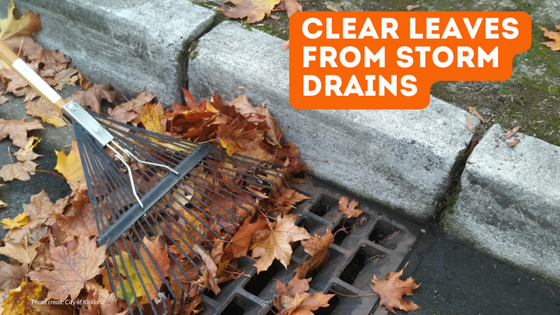 Use a rake to clear leaves away from a storm drain to prevent localized flooding.
Prepare your home for the wet weather season
Fall has arrived! The average rainfall in Kitsap County is 41 inches, with much of that precipitation occurring in the fall and winter. Rain combined with falling leaves is the perfect recipe for clogging storm drains.
Kitsap County Public Works and your local jurisdictions work hard to reduce flooding potential, but community members can help reduce the chance of flooding in their neighborhoods. Take advantage of sunny days and prepare your home for the rainy season.
How to prevent clogged storm drains
- Keep neighborhood storm drains free of leaves and debris.
- If you see a clogged storm drain, use a rake, shovel handle, or stick to clear the drain.
- If this does not help, report the blockage on Kitsap County's app: SeeClickFix.
- NEVER remove a storm drain lid or attempt to clean a drain in a busy street.
- Do not wade into water when you are unsure of the depth.
Check your gutters and downspouts
- Clear gutters and downspouts of leaves and debris.
- Replace leaky or broken gutters.
- Make sure downspouts are directed away from your house.
Disposing of leaves
- Dispose of leaves by turning them into compost for your garden, putting them in curbside yard waste bins, or taking them to local composting facilities.
- If you use a landscaping company, ask the landscaper to take the leaves with them.
- Do not blow or sweep leaves into the road, ditches, or storm drains.
Preparing for floods
Fall is a good time to revisit your emergency preparedness plans. If your home is in an area that may experience flooding, there are a few steps you can take to prepare. To determine your property's flood risk, you can look up your property on the Federal Emergency Management flood risk website.
Flooding preparedness can include tracking the tides and weather conditions, creating an evacuation plan, and preparing a “go bag” in case evacuation is needed.
Flood Preparation Resources
|
